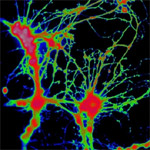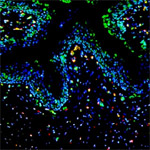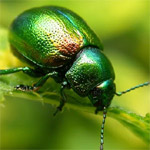York Science and Innovation Grand Tour
University of York departments and centres are taking part in the Grand Tour, a visual celebration of York’s phenomenal achievements in science and innovation. They include:
Dr Gareth Evans and Dr Peter O'Toole, Department of Biology

Neurobiologists at the University of York use fruit flies and cultured brain cells to study learning and dementia.
Calcium isn't just good for healthy teeth and bones, it's also an important signalling molecule in the brain. The picture shows calcium in cultured neurons, with warmer colours indicating high calcium. When we learn, calcium levels rise, telling neurons to strengthen connections with their neighbours and thus encode memories.
York JEOL Nanocentre

Colouring agents used by medieval glaziers to create stained glass windows in York Minster contained tiny gold and silver fragments now known as nanoparticles.
More recently, nanoparticles have found application in the fields of chemistry, medicine and biology amongst others. The York JEOL Nanocentre at the University of York specialises in the study of these nanoparticles and has state-of-the-art facilities that enable us to examine single atoms like those depicted in this image.
Professor Jenny Southgate, Jack Birch Unit

York scientists were the first to create human bladder tissue in the laboratory and this is now being used to find new treatments for bladder diseases including cancer.
Bladder cancer is the seventh commonest cancer, affecting twice as many men as women. Researchers from the Jack Birch Unit at the University of York have discovered a way to grow human bladder tissue in the laboratory, which can be used to study bladder diseases and to tissue-engineer replacement bladders.
Dr Geoff Oxford, Department of Biology

University of York researchers have used the iconic Tansy beetle to explore important ecological processes and to establish a model system for future insect conservation.
Tansy beetles (Chrysolina graminis) in Britain are found only within 25km of York on the banks of the River Ouse, often feeding on the leaves of their favourite food, the tansy plant. Their beautiful iridescent green colouring has led to them being christened the ‘Jewel of York’.
Further information
